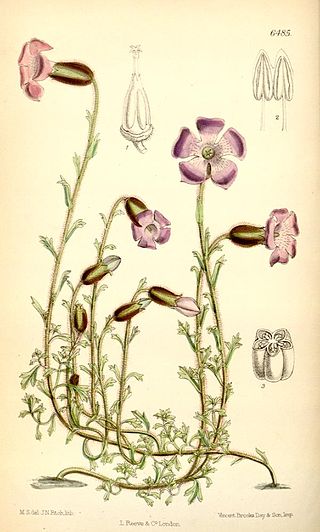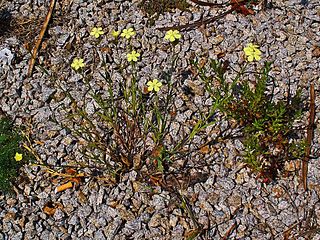
The Miljacka is a river in Bosnia and Herzegovina that passes through Sarajevo. Numerous city bridges have been built to cross it.

Cyananthus lobatus, commonly known as the lobed-leaved cyananth or trailing bellflower, is an ornamental flowering plant of the family Campanulaceae.
Ali Pasha Rizvanbegović was a Herzegovinian Ottoman captain (administrator) of Stolac from 1813 to 1833 and the semi-independent ruler (vizier) of the Herzegovina Eyalet from 1833 to 1851. The eyalet had been created specifically for him as a reward for helping to suppress the local Gradaščević Rebellion against the Ottoman Empire. However, he was deposed and summarily executed when the authorities in Constantinople discovered that he was hatching plans to rule Herzegovina independently of the Porte.

Iris orjenii, the Orjen iris, is a rare species of iris found in Montenegro and Bosnia and Herzegovina on the karst landscape of Orjen mountain. It grows in the wild on grassy slopes at 1,500 to 1,700 m, in sunny or semi-shaded locations within Bosnian Pine communities. It is a member of the subgenus Iris, meaning that it is a bearded iris, and grows from a rhizome.

Herzegovina is the southern and smaller of two main geographical regions of Bosnia and Herzegovina, the other being Bosnia. It has never had strictly defined geographical, cultural or historical borders, nor has it ever been defined as an administrative whole in the geopolitical and economic subdivision of Bosnia and Herzegovina.

Elaeocarpus bancroftii, commonly known as Kuranda quandong, Johnstone River almond, ebony heart, grey nut, or nut tree is a large rainforest tree in the family Elaeocarpaceae which is endemic to Queensland. It has coriaceous leaves, attractive white flowers and relatively large fruit containing an edible kernel.

Favratia zoysii, known commonly as Zois' bellflower, Zoysi's harebell, or crimped bellflower, is the sole member of the genus Favratia, closely related to Campanula (bellflowers).

Ptychosperma elegans, commonly known as the solitaire palm, is a very slender palm endemic to Queensland in Australia. In the nursery trade and in the United States it may be confusingly referred to as Alexander palm, which is an often-used but misnomered name of another Australian palm species Archontophoenix alexandrae, the Alexandra palm.
Cherleria handelii, or Handei-Maceti's sandwort, is a perennial plant of the family Caryophyllaceae. It is a stenoendemic from the mountain Čvrsnica, Bosnia and Herzegovina.

Edraianthus sutjeskae, or Sutjeska's rockbell, is the endemic plant of the family Campanulaceae . This species is separated from populations of Edraianthus serpylifolius.
Minuartia bosniaca, or Bosnian sandwort, in Bosnian bosanska mišjakinjica, is endemic plant at East Dinaric mountains. Itbelongs to family of Caryophyllaceae (carnations).
Asperula hercegovina, commonly known as the Hercegovinian woodruff, is a herb endemic to Bosnia & Herzegovina of the Rubiaceae family.
Euphorbia gregersenii, or Gregersen's spurge, is a plant in the family Euphorbiaceae: spurges.

Dianthus knappii, or Knapp's carnation, in Bosnian Knapov karanfil or Knapov klinčić, is a perennial herbaceous plant in the carnation family, Caryophyllaceae. It is endemic at Dinaric mountains, on the border area between Herzegovina and Montenegro. In chromosome set has 2n = 30.
Dianthus freynii, or Freyn's carnation, in Bosnian Freynov karanfil or Freynov klinčić, is native endemic of Herzegovina karst, Bosnia and Herzegovina. It belongs to the family Caryophyllaceae (carnations).

Oxytropis prenja G. Beck in Reichenb. & Reichenb. Fil. is a species of flowering plant in the legume family, Fabaceae.

Trg oslobođenja - Alija Izetbegović is a square in Sarajevo, Bosnia and Herzegovina. It lies between the municipalities Stari Grad and Centar. It links the main pedestrian thoroughfare of the Sarajevo old town, Ferhadija street, with Zelenih Beretki street, with the Dom Armije (1881). On its east side it hosts the Orthodox Cathedral (1874) and the University of Sarajevo School of Economics and Business. On its west is the Svjetlost building, while at its south, beyond Zelenih Beretki, stands the Dom Armije (1881)
Zanthoxylum austrosinense, or South Chinese Sichuan pepper, is a woody plant in the family Rutaceae and is native to southern China.
Zanthoxylum dissitum is a woody plant native to China. It grows in upland thickets and open forests, forests, at 300-2600 m altitude.
Zanthoxylum laetum is a species of woody plant from the Rutaceae family.











